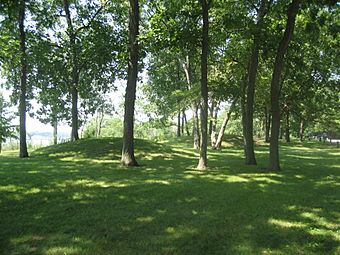Sinnissippi Mounds facts for kids
Quick facts for kids |
|
|
Sinnissippi Site
|
|
 |
|
| Location | Sterling, Whiteside County, Illinois |
|---|---|
| Area | 6 acres (2.4 ha) |
| Built | c. 1 BCE |
| Architectural style | Burial mound |
| NRHP reference No. | 79000874 |
| Added to NRHP | May 14, 1979 |
The Sinnissippi Mounds are ancient burial mounds. They were built by the Havana Hopewell culture. You can find them in Sterling, Illinois, in the United States. These mounds are like special hills that people built long ago.
Contents
Who Were the Hopewell People?
The Sinnissippi Mounds were created by the Hopewell tradition. This was a group of Native American cultures. They lived in the Sterling area about 2,000 years ago. At that time, this area was very important. It was a center for a huge trade network. This network stretched along the Mississippi River. Similar mounds are common in the Mississippi and Ohio River Valley areas.
Life of the Hopewell Culture
The Hopewell people were skilled artists and traders. They created beautiful objects. These included pottery, tools, and jewelry. They traded these items across long distances. The mounds they built were often used for burials. They also served as important ceremonial places.
Discovering the Mounds
The first European settler in Sterling was Hezekiah Brink. He saw the mounds when he arrived in 1834. Later, a group of early European settlers formed a Science Club. This club was called the Sterling Scientific Club. It started in the 1870s. One of their goals was to study the burial mounds. These mounds were located near the Rock River.
Early Investigations
In 1877, a person named W. C. Holbrook studied the mounds. He wrote a detailed report about them. This report was published in a book. The book was called History of Whiteside County, Illinois. One year later, another report appeared. It was in The Sterling Daily Gazette newspaper. Sadly, after the 1870s, many valuable items were taken from the mounds. This made it harder for archaeologists to study them fully.
The Sinnissippi Site Today
The Sinnissippi Mounds are part of Sinnissippi Park. This is the largest park in the Sterling Park District. The park bought the land for the mounds over time. The first part was acquired in 1934. The mounds are found on a bluff. This bluff overlooks the Rock River.
On May 14, 1979, the mound area became special. It was added to the U.S. National Register of Historic Places. It is known as the Sinnissippi Site. Even though it's a public park, it's listed as an "address restricted" site. This helps protect the historical importance of the area.


